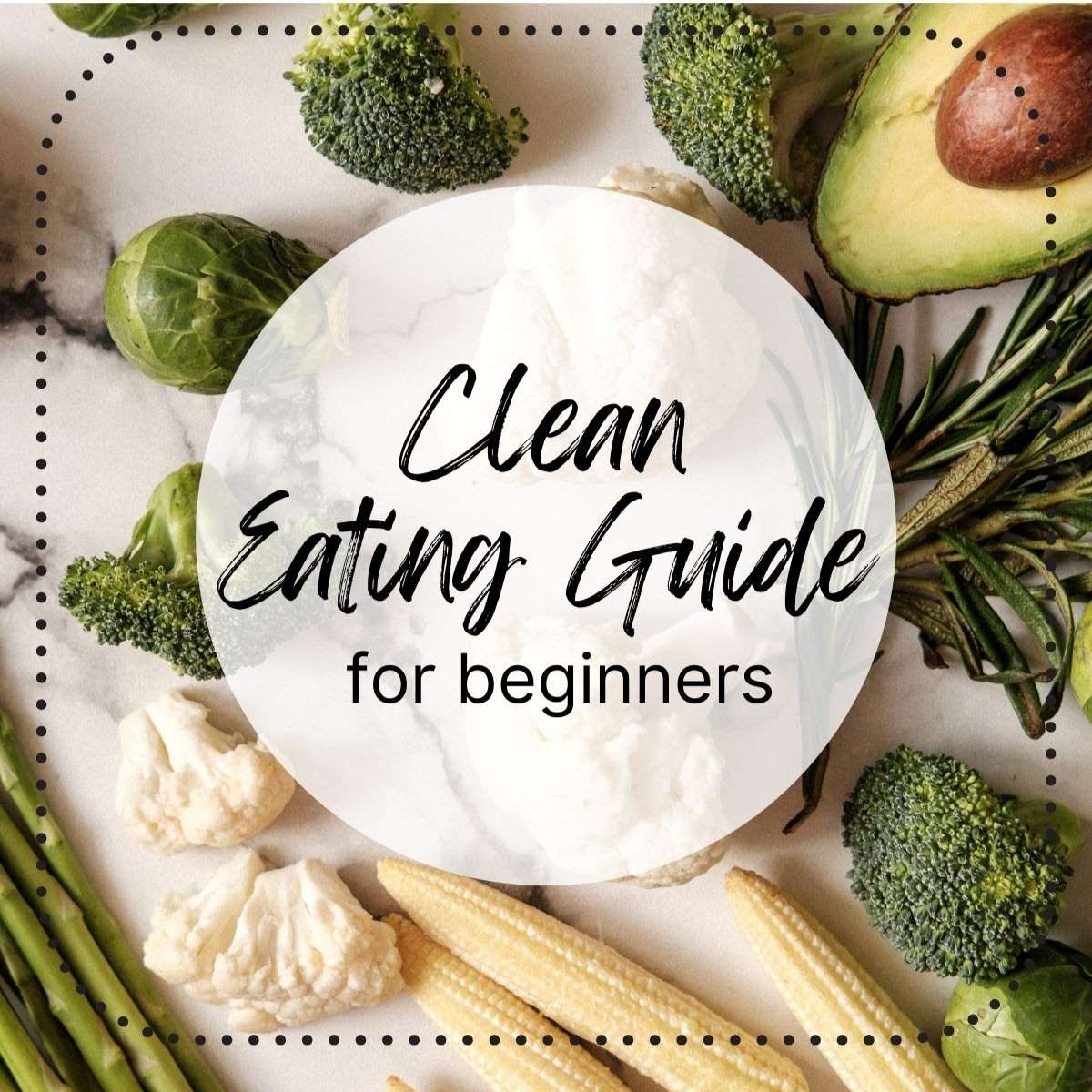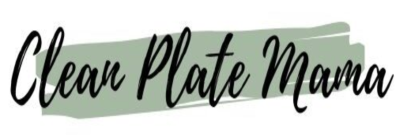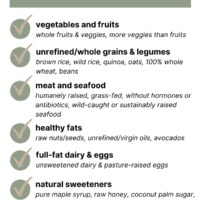Welcome to Clean Eating for Beginners! This easy guide will teach you the basics for eating clean and give you some easy ideas on starting your clean eating lifestyle.

Clean eating is a huge passion of mine. Ever since my first daughter was born, I have been very dedicated to feeding my family real/wholesome foods to support both our emotional and physical health.
And it’s important to note that eating clean is not a diet, but an approach to how and what you eat. Eating clean is also not all or nothing. I whole heartedly believe in a balanced approach. You don't need to completely avoid certain things or think you can't ever enjoy some French fries or a bowl of ice cream.
What Does Clean Eating Mean?
Eating clean means eating whole/real nutrient dense foods (one ingredient) and keeping your food as close to nature as possible. Real food is food that is consumed as nature intended or requires very little processing.
You’ll notice I use the terms real food and clean food synonymously. These are foods that are whole in nature, minimally processed/or not at all processed, no additives, and preferably no pesticides (organic). Clean foods are high quality foods that benefit your overall health.
What real food isn’t? Real food is NOT food that was created in a lab, or food that has gone through extreme processing to make its way to our plates.
You also don’t need to give up an entire food group. You can still eat clean and eat grains, wheat, dairy, meat. As long as you as an individual don’t have issues with certain foods, you can still eat it all, you just need to know what to look for.
Clean Eating Guidelines
Here I will break down clean eating for you into six easy categories. Within each category you’ll find some additional information on how to eat clean and what to look for when you’re shopping.

VEGETABLES & FRUITS
Organic when possible.
- Focus on eating fruits and vegetables as much as possible and getting in a good variety (seasonal and local are even better).
- When deciding organic/non-organic, focus on buying organic for items that contain the highest amount of pesticide residue. That list can be found under the Environmental Working Groups (EWG) Dirty Dozen List (which is updated yearly).
UNREFINED GRAINS AND LEGUMES
Must be 100% whole wheat or whole grains.
- Examples of whole, unrefined grains include brown rice, wild rice, quinoa, oatmeal, and popcorn.
- Always look for whole wheat flour. Whole wheat flour is different than wheat flour, so make sure the word "whole" is listed.
- Properly prepared beans and legumes, meaning if buying canned, look for BPA-free cans and ones that contain just beans, water, and maybe salt.
MEAT & SEAFOOD
Organic and grass-fed beef, organic poultry, and wild-caught or sustainable seafood.
- Grass-fed beef is much healthier, is better quality, and is better for the environment. Typically grass-fed beef is organic by nature.
- For chicken and other non-beef meat sources, organic ensures they are given organic feed and aren't treated with antibiotics (federal regulations prohibit the use of growth hormones in poultry and pork). It also means they have access to the outdoors.
- Look for wild-caught or sustainable seafood.
HEALTHY FATS
Raw nuts/seeds, unrefined oils, avocados.
- Focus on using extra-virgin olive oil (EVOO), coconut oil, and avocado oil (avoid vegetable oils, canola oil, safflower/sunflower and peanut oil; most of these are derived from genetically modified crops, are highly processed, and are inflammatory).
- Stock up on avocados and add in nuts/seeds (raw and unsalted).
DAIRY & EGGS
Full-fat unsweetened dairy and pasture-raised eggs.
- Organic and grass-fed/pasture-raised dairy.
- Buy full fat/whole milk products. Whole milk is closer to its natural state and contains more of the key nutrients as opposed to low-fat versions which have gone through more processing. Raw is even better.
- Certified pasture-raised eggs.
NATURAL SWEETENERS
Natural and unrefined.
- Honey, pure maple syrup, coconut sugar, and dates. Enjoy in moderation.
How to Start Clean Eating
Starting your journey with clean eating can feel very overwhelming, but good news for you… it doesn’t’ have to be! And it doesn’t have to be all or nothing right away.
Here are some simple things you can do to get you on the right track to clean eating.
- Start by reading the ingredient labels of the food you already have in your fridge and pantry. Start to notice the number of ingredients and what the ingredients are. Can you pronounce them? Can you buy them at the store yourself?
- Notice the amount of sugar in your packaged foods.
- Start small – pick one meal a day to be 100% clean.
- Eat more vegetables and fruits (try to have a vegetable with every meal).
- Swap one thing at a time – for example, instead of grabbing for a bag of chips, grab a handful of raw nuts or an apple and peanut butter. If you put a lot of sugar laden creamer in your coffee, switch to whole milk (and if you like the sugar, add a tiny bit of pure maple syrup instead).
- Even if it's not 100% clean, start to simply cook more meals at home.
- Start by just adding more whole foods into your diet before you start eliminating.
- Meal plan and cook ahead – even if that just means having veggies cut up and ready to eat in the fridge.
What About Packaged Food?
Ah yes, packaged food… aka processed foods! It’s hard to make everything from scratch and let’s be honest… a lot of the time, the convenience of processed foods has to win in the busy lives we all live.
When I do buy packaged food, I read the ingredient list, not the nutrition label. Have you ever heard of the saying "count chemicals, not calories"? Well, that is what I go by!
When reading the ingredient list I look for foods with minimal ingredients (the less ingredients the less processing). And the more our food is processed, the more likely that nutrients are taken from the food, so you’re left feeling unsatisfied and nutritionally depleted.
I also look for ingredients that are real/whole foods that I could actually buy at the grocery store myself. For example, I love the brand Simple Mills. Their pancake mix and crackers contain simple ingredients I could purchase.
And the occasional overly processed food is not going to be detrimental to your health, so don’t sweat it if you indulge once in a while.

What Does Clean Eating Look Like For Me?
As I previously mentioned, clean eating is not all or nothing. And that holds true for my approach as well.
I avoid gluten and dairy as much as possible, however, if dairy and gluten aren’t an issue for you, I truly believe these both can be part of a balanced clean eating lifestyle, as long as you are eating the right gluten and dairy containing foods. I don’t believe you have to completely eliminate entire food groups to eat clean.
I focus my meals on a protein, healthy fat, and mostly veggies. I eat gluten-free/whole grains (but I do limit them). I’m not a huge snacker, but when I do snack it’s usually raw nuts, simple mills crackers, fruit (dried of fresh), beef sticks, or a homemade energy/bliss ball.
But, I have a secret for you... sometimes I break all the rules for clean eating and enjoy a nice meal out that's not always clean or eat a piece of cake! I truly believe everything in moderation!
To sum it up, I take the 80/15/5 approach.
- 80% whole/unprocessed foods
- 15% better-for-your processed foods
- 5% “junk”
And there you have it. I hope this was useful information for you! Please comment below if you have questions, or if you enjoyed this post. Best of luck on your clean eating journey!
And for an even more detailed breakdown of how to eat clean, sign up below for my FREE Guide to Real Food!
Please note that I am not a trained dietitian or nutritionist. The views represented on this post are my personal viewpoint and are based on years of research and living my own clean eating lifestyle.



